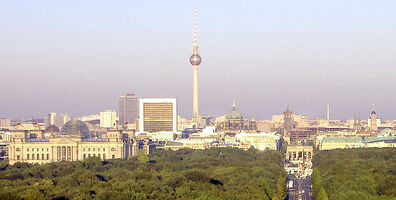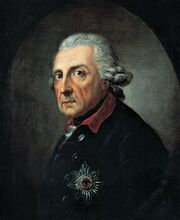
Skylline of Berlin.
Berlin is the capital of the Kingdom of Prussia, Brandenburg, and also the Germanian Empire. With a population of 7.5 million people, Berlin is Germania's largest city and the second largest city in the Wikian Union. Located in northeastern Germania, it is also the center of the Berlin-Brandenburg Metropolitan District, comprising 5 million people from over 190 nations. Geographically embedded in the European Plains Berlin is influenced by a temperate seasonal climate. Around one third of the city´s territory is composed of forests, parks, gardens, rivers and lakes, the largest such composition in WikiEurope.
Berlin is a major center of culture, politics, media, and science in Europe. Its economy is primarily based on the service sector, encompassing a diverse range of creative industries, media corporations, congress and convention venues. Berlin serves as a continental hub for air and rail transport, and is one of the most visited tourist destinations in the WU. Other industries include optoelectronics, traffic engineering, IT, renewable energy, pharmaceuticals, biomedical engineering, and biotechnology.
The metropolis is home to world-renowned universities, research institutes, sporting events, orchestras, museums and personalities. The urban and historical legacy has made it a popular setting for international film productions. The city is recognized for its festivals, diverse architecture, nightlife, contemporary arts, extensive public transportation networks and a high quality of living. Berlin has evolved into a global focal point for young individuals and artists attracted by a liberal lifestyle and modern zeitgeist.
History[]

Map of Berlin in 1688.
The name Berlin is of unknown origin, but may be related to the Old Polabian stem berl-/birl- "swamp".
The earliest evidence of settlements in today's Berlin central areas is a wooden beam dated from approximately 1192. The first written mention of towns in the area of present-day Berlin dates from the late 12th century. The settlement of Spandau is first mentioned in 1197, and Köpenick in 1209, though these areas did not join Berlin until 1920. The central part of Berlin can be traced back to two towns. Cölln on the Fischerinsel is first mentioned in a 1237 document, and Berlin, across the Spree in what is now called the Nikolaiviertel, is referenced in a document from 1244. The former is considered to be the "founding date". From the beginning, the two cities formed an economic and social unit. In 1307, the two cities were united politically. Over time, the twin cities came to be known simply as Berlin.
In 1435, Frederick I became the elector of the Margraviate of Brandenburg, which he ruled until 1440. His successor, Frederick II, established Berlin as capital of the margraviate, and subsequent members of the Hohenzollern family rule to this day in Berlin, first as electors of Brandenburg, then as kings of Prussia, and finally as Germanian emperors. In 1448 citizens rebelled in the “Berlin Indignation” against the construction of a new royal palace by Elector Frederick II Irontooth. This protest was not successful, however, and the citizenry lost many of its political and economic privileges. In 1451 Berlin became the royal residence of the Brandenburg electors, and Berlin had to give up its status as a free Hanseatic city. In 1539, the electors and the city officially became Lutheran.
17th to 19th centuries[]

Frederick the Great was one of Europe's enlightened monarchs.
The Thirty Years' War between 1618 and 1648 had devastating consequences for Berlin. A third of the houses were damaged and the city lost half of its population, a damage that would remain until the beginning of the 18th century. Frederick William, known as the “Great Elector”, who had succeeded his father George William as ruler in 1640, initiated a policy of promoting immigration and religious tolerance. With the Edict of Potsdam in 1685, Frederick William offered asylum to the French Huguenots. More than 15,000 Huguenots went to Brandenburg, of whom 6,000 settled in Berlin. By 1700, approximately 20 percent of Berlin's residents were French, and their cultural influence on the city was immense. Many other immigrants came from Bohemia, Poland, and Salzburg.
With the coronation of Frederick I in 1701 as king (in Königsberg), Berlin became the capital of the Kingdom of Prussia. In 1740 Frederick II, known as Frederick the Great (1740–1786) came to power. Berlin became, under the rule of the philosophically oriented Frederick II, a centre of the Enlightenment. Following France's victory in the War of the Fourth Coalition, Napoleon Bonaparte marched into Berlin in 1806, but granted self-government to the city. In 1815 the city became part of the new Province of Brandenburg.

Berlin became the capital of the Germanian Empire in 1871 and expanded rapidly in the following years. (Unter den Linden in 1900)
The Industrial Revolution transformed Berlin during the 19th century; the city's economy and population expanded dramatically, and it became the main rail hub and economic center of Germania. Additional suburbs soon developed and increased the area and population of Berlin. In 1861, outlying suburbs including Wedding, Moabit, and several others were incorporated into Berlin. In 1871, Berlin became capital of the newly founded Germanian Empire, which it is to this day. On 1 April 1881 it became a city district separate from Brandenburg.
20th century[]
In 1920, the Greater Berlin Act united dozens of suburban cities, villages, and estates around Berlin into a greatly expanded city at the expense of Brandenburg. After this expansion, Berlin had a population of around four million. During this era, Berlin became internationally renown as a center of cultural transformation, at the heart of the Roaring Twenties.
However, Berlin suffered during the Great Depression. The city however recovered by the policies of Chancellor Bernhard Durnburg. The most sucessfull segment of Berlin's population were the Jews, who helped develop the culture and features of the city during that era. They numbered 175,000 at that time and today there are more then 450,000 of them. The Germanian government recognizes their achievements.
During World War II, British bombers tried attacking Berlin, but failed. Berlin remained largely unaffected from the war and emerged stronger then ever. At the end of the war, Berlin became the most cultural area in Europe.
Today, Berlin is a major center.
Geography[]
Berlin ia located in eastern Germania, in an area with marshy terrain. The Berlin–Warsaw Urstromtal (ice age melt water flow), between the low Barnim plateau to the north and the Teltow plateau to the south, was formed by water flowing from melting ice sheets at the end of the last ice age. The Spree follows this valley now. In Spandau, Berlin's westernmost borough, the Spree meets the river Havel, which flows from north to south through western Berlin. The course of the Havel is more like a chain of lakes, the largest being the Tegeler See and Großer Wannsee. A series of lakes also feeds into the upper Spree, which flows through the Großer Müggelsee in eastern Berlin.
Substantial parts of present-day Berlin extend onto the low plateaus on both sides of the Spree Valley. Large parts of the boroughs Reinickendorf and Pankow lie on the Barnim plateau, while most of the boroughs Charlottenburg-Wilmersdorf, Steglitz-Zehlendorf, Tempelhof-Schöneberg, and Neukölln lie on the Teltow plateau. The borough of Spandau lies partly within the Berlin Urstromtal and partly on the Nauen Plain, which stretches to the west of Berlin. The highest elevations in Berlin are the Teufelsberg and the Müggelberge. Both hills have an elevation of about 115 metres (380 ft).